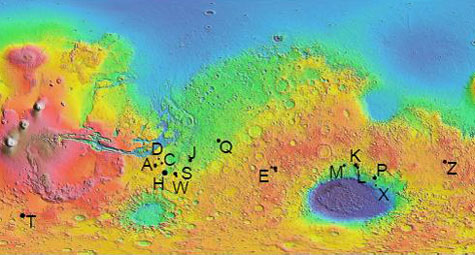| Alluvial Fans on Mars: Overland runoff volumes and formation time |
 |
Project Summary
Personnel: Kelli Wakefield (M.S.) Phil Christensen (Ph.D.) The role of liquid water on Mars has been a topic of much debate and interest since Mariner 9 returned images of the surface showing channels resembling terrestrial fluvial channels. Alluvial fans identified on Mars are one of the more definitive evidences for liquid water flowing on the Martian surface and preserve information about the hydrologic conditions at the time of their formation. These fans are found in three clusters located in Margaritifer Terra, Terra Sabaea, and Tyrrhena Terra. The fans are located in craters dated to the Noachian period and the fans themselves are dated to the Noachian-Hesperian boundary. A theoretical relationship between the slope of alluvial fans and the water to sediment discharge ratio -- tested against laboratory and field data under terrestrial conditions -- is utilized to determine overland runoff volumes and minimum flow durations required for the formation of large alluvial fans on Mars. These volumes were calculated for both gravel and sand fans forming by either expanding sheetfloods or channelized flow. Where possible, bankfull water discharge at the apex of fans was determined from the width of feeder channels. The large volumes of water required to form the fans and the large discharge at the apex of the fan suggest that groundwater would not be an adequate source for water to form these alluvial fans. As has been suggested in previous works, precipitation, in the form of rain or snow, is a likely candidate water source. We combine our estimates of total water volumes and water discharges (or equivalently total sediment volumes and estimated sediment flux) to determine minimum formation times for the fans, with some interesting implications. |